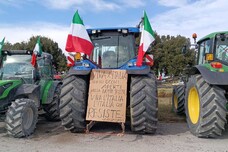The lives of the slaves who kept the
Ancient Roman rich in their often opulent settings in Pompeii
have been revealed by a fresh dig just outside the walls of the
ancient city near Naples.
The furnishings of a room assigned to slaves have been found in
the Roman villa of Civita Giuliana, about 600 metres from the
walls of ancient Pompeii.
The discoveries are almost 2,000 years old, and made, said the
Italian culture ministry in announcing the new finds, using the
technique of casts, which has only been employed in and around
Pompeii.
Furniture and textiles, as well as the bodies of many more
victims of the 79 AD eruption, were covered by the pyroclastic
cloud, which then became solid ground while decomposed organic
matter left a void in the ground: an imprint that, when filled
with plaster, revealed its original form.
Culture Minister Gennaro Sangiuliano was visibly satisfied,
saying: "What has been reconstructed confirms the need to
continue scientific research in a place that has been wrested
from the looting and illegal trafficking of archaeological
goods".
ALL RIGHTS RESERVED © Copyright ANSA











